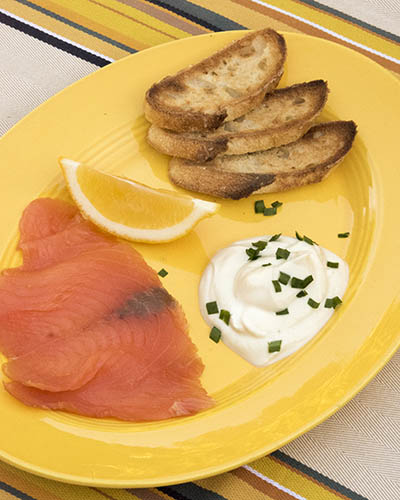During college, I spent half of my sophomore year studying in Aix-en-Provence, in the south of France. That’s where I learned to love cheese in all its forms, from stinky puant de Lille (literally, the “reeking cheese from Lille”) to rock-hard chèvres. I often ate lunch in the university cafeteria because it was so tasty, and more often than not, the meal ended with little containers of Petit Suisse, a super-fresh cream-enriched cow’s milk cheese that you sprinkled with sugar and ate like yogurt. What a delicious and wholesome dessert.
Vermont Creamery’s Fromage Blanc (pictured above) is not nearly so rich, but it resuscitates that happy taste memory. If I sprinkle it with sugar or brown sugar, I am 19 years old and back in France. The creamery makes it with skim milk, but you wouldn’t know it. It is moist and spoonable, thick and tangy, and the only nonfat cheese I enjoy. You can have it for breakfast with fresh or poached fruit, or spread it on toast with jam or honey. It can stand in for cream cheese when you’re serving bagels or smoked fish—it’s lighter on the tongue and lower in calories. If you’re using it in a savory way, fold in some snipped chives and chopped parsley or a little scraping of garlic.
Fromage blanc is where cheese begins. It is simply fresh milk, cultured and fermented until it thickens, then drained in a bag to remove whey. It is ready for sale within hours. Like cottage cheese or ricotta, it doesn’t last, so plan to use a tub within a couple of days of opening it.
After so much holiday excess, light fresh cheeses have a lot of appeal. Instead of offering dinner guests a massive cheese tray, think instead about spooning some fromage blanc onto a platter, drizzling it with honey and surrounding it with candied walnuts and sliced Medjool dates.
The two recipes that follow should help you discover the pleasures of fromage blanc. And if you ever spot those little plastic tubs of Petit Suisse, here or in France, don’t pass them by.
Grape Focaccia with Goat Fromage Blanc
Goat Fromage Blanc
From The Cheese Course by Janet Fletcher (Chronicle Books).
- 2 quarts goat’s milk
- 1 package fromage blanc direct-set culture
In a saucepan, heat the milk over medium heat to 170°F on an instant-read thermometer, stirring occasionally. Immediately transfer the saucepan to an ice bath to cool the milk quickly to 72°F. Remove the saucepan from the ice bath and stir in the culture. Cover and let stand at room temperature, preferably at 72°F, until mixture sets into a yogurt-like custard, 12 to 15 hours.
Line a colander with a triple thickness of cheesecloth. Gently ladle the curd into the cheesecloth, then lift the edges of the cloth to form a bag. Tie the bag shut and suspend over the sink or over a bowl to drain until the fromage blanc is as thick as you like, 4 to 6 hours. You may need to open the bag once and scrape some of the thickened cheese away from the surface of the cheesecloth to speed draining. Transfer to a bowl and stir in salt to taste.
Makes about 1 pound
Vermont Creamery’s Greek Dip
From In a Cheesemaker’s Kitchen by Allison Hooper (The Countryman Press).
- 8 ounces fromage blanc
- 1 tablespoon fresh dill or mint, chopped
- 1 clove garlic, finely minced
- ¼ teaspoon freshly ground pepper
- ¼ teaspoon sea salt
- 1 small cucumber, peeled, seeded and chopped
Put all ingredients in a food processor and pulse until mixed well. The dip will keep in the refrigerator for 3 days.


